For CIOs leading enterprise transformations, portfolio health isn’t just an operational indicator — it’s a real-time pulse on time-to-market and resilience in a digital-first economy. Understanding and tracking the right software delivery metrics is essential to inform strategic decisions that drive continuous improvement. In today’s digital-first economy, enterprise architecture must also evolve from a control function to an enablement platform. This transformation requires a fundamental shift in how we approach technology delivery — moving from project-based thinking to product-oriented architecture.
The stakes have never been higher. In today’s digital economy, business objectives like “becoming a leading global wealth management firm” or “being a premier destination for top talent” demand more than just technical excellence. They require fundamentally reimagining how we approach enterprise architecture and technology delivery.
Key takeaways:
- Traditional architecture approaches focused on control and standards are failing to meet modern business needs
- Successful transformation requires a shift from “master builder” to “urban planner” mindset and then translated into self-sustainable entities
- Four critical pillars drive success: business value delivery, technical foundation, devsecops maturity and thriving engineering community
- Measuring portfolio health through clear metrics enables data-driven decision-making
- Cultural transformation and talent development are as crucial as technical excellence
Expected benefits:
- Faster time to market for new initiatives
- Small teams focused on well-defined outcomes
- Reduction in system incidents
- Improvement in developer productivity
- Enhanced ability to attract and retain top talent
- Stronger alignment between technology and business outcomes
I. The modern enterprise architecture challenge
Today’s enterprises face a critical inflection point. In a world where software defines competitive advantage, traditional approaches to enterprise architecture — focused on control, standards and governance — are failing to deliver the speed and resilience businesses require.
The traditional approach is failing
Imagine being tasked with developing a rapidly growing metropolitan area. Would you focus solely on approving individual building permits, or would you first establish a comprehensive city plan that considers infrastructure, sustainability and community needs? Unfortunately, many organizations still approach their technology landscape like overeager developers rather than thoughtful city planners — focusing on individual projects without considering the broader ecosystem’s health and sustainability.
The cost of inaction
Organizations clinging to traditional architecture approaches face:
- Mounting technical debt
- Increasing system complexity
- Rising operational costs
- Difficulty attracting talent
- Slower time to market impacting competitive advantages
- Reduced competitive advantage
The evolution of enterprise architecture
Modern enterprise architecture requires thinking like an urban planner rather than a building inspector. This means creating environments that enable innovation while ensuring system integrity and sustainability.
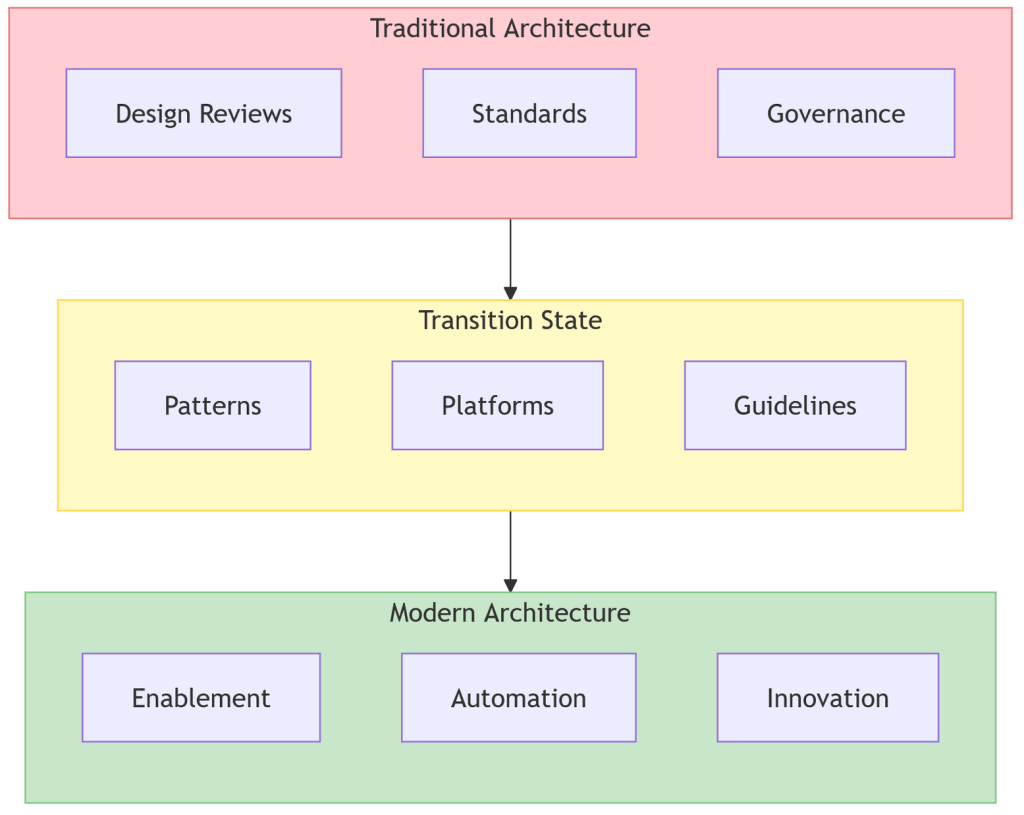
Shawn McCarthy
From building inspector to urban planner
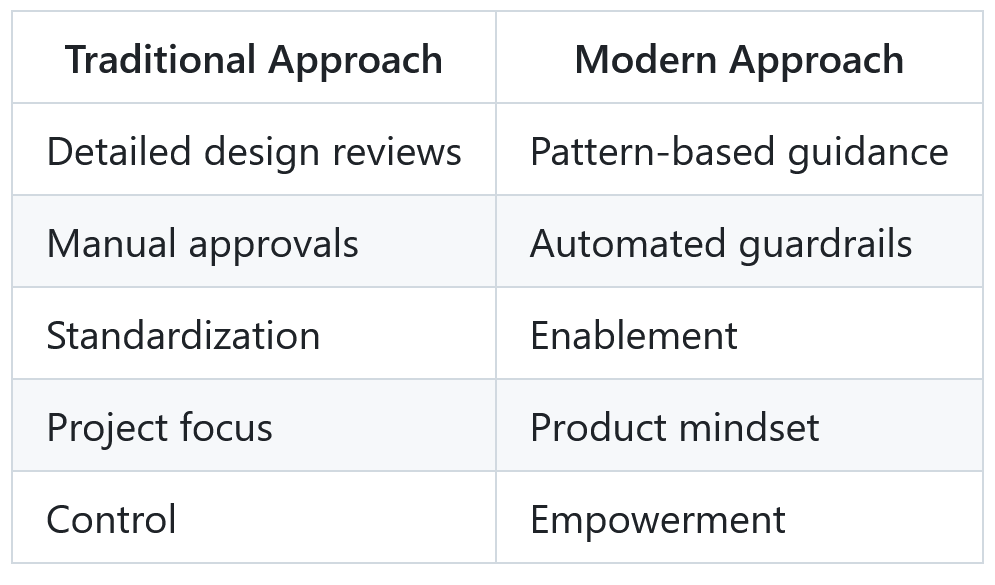
Shawn McCarthy
Now imagine this new evolved world, having access to pre-approved building templates, standardized utility connections for any commodity service, and clear zoning guidelines that enable rapid, reliable construction while ensuring neighborhood cohesion. This is the promise of modern enterprise architecture — providing higher-level building blocks that enable innovation and rapid business reconfiguration while maintaining system integrity. Rather than forcing every team to become infrastructure experts and building their own utilities and commodity services we create platforms and patterns that abstract away complexity while ensuring quality and consistency. By offering higher-level abstractions — platforms, patterns, shared-services and guardrails — enterprise architects reduce toil, preserve quality and accelerate product delivery.
Creating a common language
Just as urban planners need to develop a shared vocabulary with city officials, developers and citizens, enterprise architects must establish a common language that bridges technical and business domains. Complex ideas that remain purely verbal often get lost or misunderstood. Documentation and diagrams transform abstract discussions into something tangible. By articulating fitness functions — automated tests tied to specific quality attributes like reliability, security or performance — teams can visualize and measure system qualities that align with business goals.
Wikipedia defines a software architect as “a software expert who makes high-level design choices and dictates technical standards, including software coding standards, tools, and platforms.” But this definition misses the essence of modern enterprise architecture. If we were going to amend this definition it would include that an architect addresses many concerns, enables integration (integration issues are often where architects focus much of their attention) and ensures the evolvability of a system. The architect often provides and is the custodian of an architecture vision for a product – which supports a continual and incremental change as a first principle among multiple dimensions.
Most importantly, architects make difficult problems manageable. They achieve this through models, patterns, and peer review — taking complex challenges and breaking them down into understandable components that stakeholders can grasp and discuss. When you take time to put ideas on paper using language everyone understands, you enable meaningful participation in critical decisions.
The ability to explain technical concepts without jargon, making them accessible to those unfamiliar with protocols and stacks, is perhaps the most crucial skill for working with broad audiences who require clarity without deep technical background.
II. The “what”: Strategic business alignment
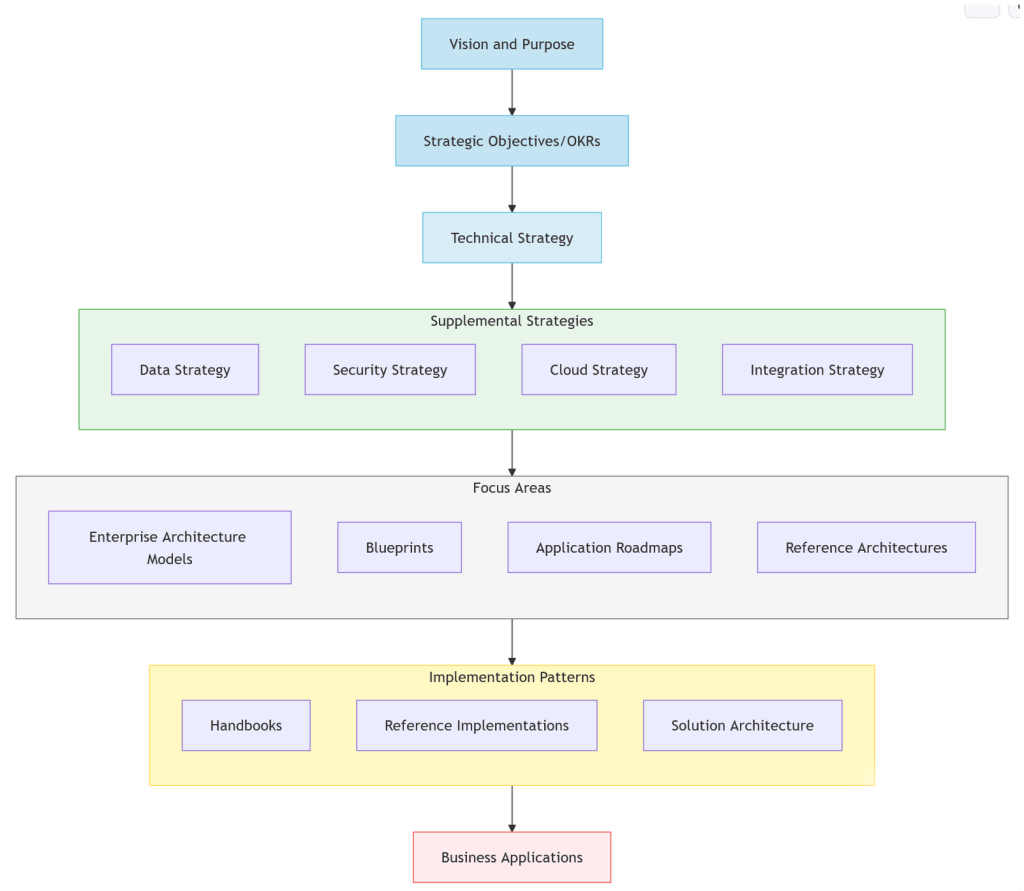
Shawn McCarthy
In an environment where you need to balance the company vision and strategic plan with delivering near-term value while also having a stable and sustainable technology ecosystem, evolving enterprise architecture is key. Technology capabilities need to be able to support the delivery of strategic business OKRs. Understanding opportunities and limitations of existing platforms and capabilities informs the city plan to prioritize investments for the growth needed.
Technology governance alone will often just inform you of capability gaps, tech debt and duplication — this could be too late! Enterprise architects must shift their focus to business enablement. This is much more proactive in understanding the business objectives and planning and mapping the path for delivery.
Moving to product-based delivery is a significant cultural change. The delivery of outcomes will depend on evolving the capabilities of multiple products. Work is no longer expressed as initiatives and funding directly supports outcomes. Translating those outcomes into features and the corresponding technology implications allows delivery teams to have focus.
Key areas to address:
- Alignment between technology capabilities and strategic business OKRs
- Evolution from technical governance to business enablement
- Frameworks for measuring architectural success
- Cultural transformation requirements
- Models for effective stakeholder engagement
- Approaches to investment prioritization
- Risk management in transformation
- Innovation enablement strategies
Just as a city’s master plan must align with its economic and social goals, our technical strategy must directly support business objectives. This alignment sets the stage for how we execute our transformation. When tied directly to strategic objectives, software delivery metrics become business enablers, not just technical KPIs. This alignment ensures that improvements in deployment frequency or time-to-restore-service translate into tangible business value — reduced time-to-market, better customer experiences and stronger competitive advantage.
III. The “how”: Building the modern enterprise
Think of your enterprise technology landscape as a growing city. Just as urban planners balance immediate construction needs with long-term community vitality, modern technology leaders must create an environment that enables both rapid delivery and sustainable growth. Let’s explore how these essential dimensions of city development map to our technology transformation journey.
Think of portfolio health as a state-level planning function. Just as state urban development offices monitor the health of different cities and provide targeted guidance based on each city’s unique challenges, our portfolio health dashboard offers a comprehensive view that helps guide different business units toward optimal outcomes.
State-level portfolio health metrics
Our dashboard tracks critical dimensions across the state, helping identify where different cities (business units) need different types of attention:
1. Business value delivery
Conversation starter: “How quickly and reliably can we deliver features that matter to our customers?”
Think of this as building vibrant city districts that attract residents and businesses.
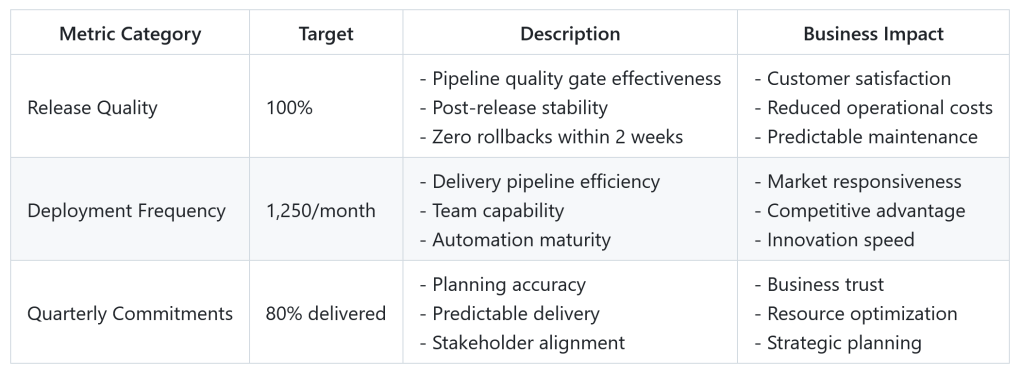
Shawn McCarthy
2. Technical foundation
Conversation starter: “Are we maintaining reliable roads and utilities, or are we risking gridlock?”
Like a city’s need for reliable infrastructure and well-maintained services.
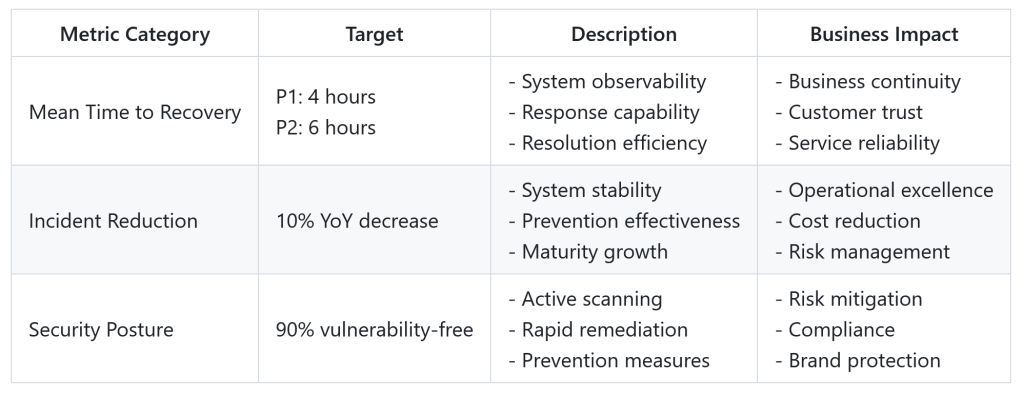
Shawn McCarthy
3. DevSecOps maturity
Conversation starter: “Are our daily operations stuck in manual processes that slow us down or expose us to risks?”
Similar to modernizing city services while maintaining daily operations.
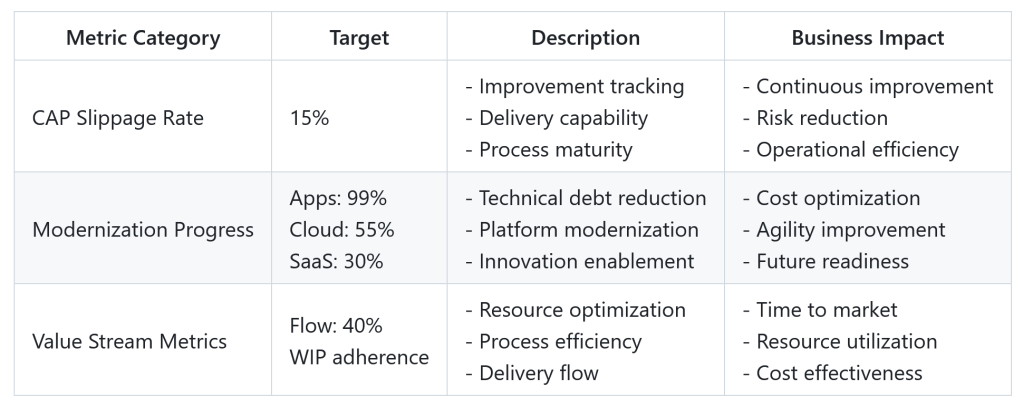
Shawn McCarthy
4. Engineering community
Conversation starter: “How do we attract and retain the best talent to grow our ‘digital city’?”
Just as great cities need engaged, skilled citizens to thrive.
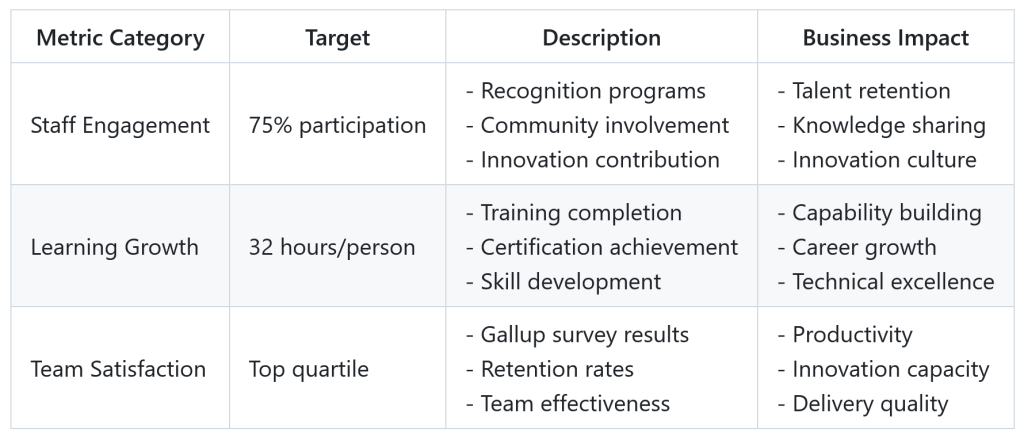
Shawn McCarthy
Using state-level insights for city planning
By consolidating these insights, CIOs and chief architects can see where to allocate resources, where risks are growing, and where future innovation might flourish. During each program increment, state-level portfolio health data guides city planners (architecture teams) in several ways:
- Identifying focus areas
- Some cities need infrastructure renewal
- Others require service modernization
- Some must improve delivery capabilities
- Resource allocation
- Target investments where most needed
- Share successful patterns across cities
- Balance local and state-wide improvements
Implementation guidelines:
- Start with the most impactful metrics for your organization
- Establish clear baseline measurements before setting targets
- Automate data collection where possible
- Review and adjust targets quarterly
- Use metrics to drive improvement, not punishment
- Share success stories and learnings across teams
Common pitfalls:
- Over-emphasizing quantity over quality
- Neglecting leading indicators
- Using metrics punitively
- Missing business outcome alignment
IV. Evolutionary architecture in practice
Just as cities must evolve while preserving their essential character, modern enterprise architecture requires built-in mechanisms for sustainable change. The “big ball of mud” architecture — where everything is tightly coupled and changes have unpredictable impacts — is like a city that grew without planning, where modifying one building might compromise its neighbors’ foundations.
Modularity and coupling: The district approach
Modern cities are organized into districts, each able to evolve independently while maintaining connections to the whole. Similarly, our architecture must support modularity along well-defined boundaries. This enables:
- Non-breaking changes to individual components
- Innovation within bounded contexts
- Risk mitigation through isolation
- Parallel evolution of different areas
Domain-driven design: Natural boundaries
Just as successful cities grow around natural community boundaries rather than arbitrary grid lines, modern architecture increasingly organizes around business domains rather than technical layers. This shift from traditional SOA (where services align with technical functions) to domain-oriented services represents a fundamental change in how we structure systems.
Experimentation: The innovation zone
Progressive cities designate innovation districts where new ideas can be tested safely. Similarly, modern architecture must enable:
- A/B testing of new features
- Canary releases for risk management
- Multiple service versions running simultaneously
- Hypothesis-driven development
A key element of evolutionary architecture is the use of fitness functions — automated checks that continuously validate architecture against desired qualities. These align directly with ISO 25010, which defines critical software quality attributes:
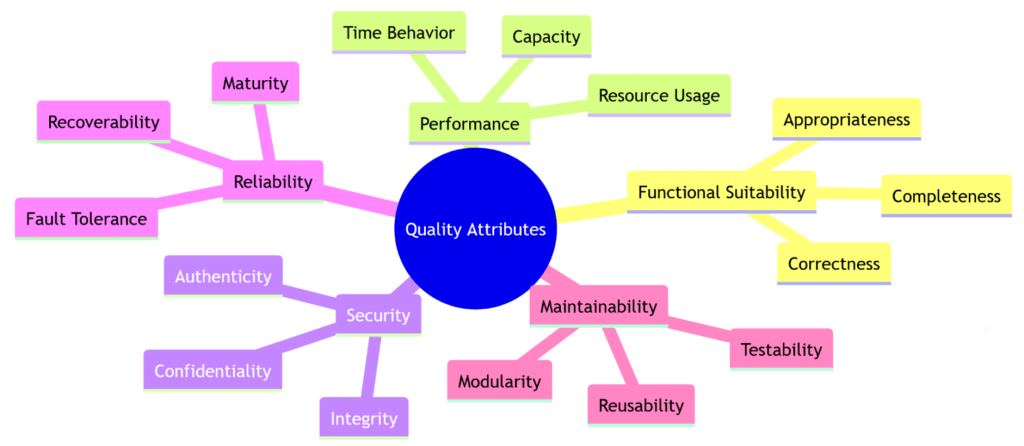
Shawn McCarthy
Example: A Performance Efficiency fitness function might continuously measure response times under peak load. A Reliability fitness function might monitor redundancy and failover mechanisms. These automated tests — built into your CI/CD pipeline — prevent regressions, drive continuous improvement, and provide real-time insights into portfolio health.
V. The new architect mindset: From Oz to Alice
An architect’s mindset should evolve from the authoritarian ‘Great and Powerful Oz,’ who instills fear and questions the courage, heart, and intelligence of others, to one that mirrors Alice’s journey — guided by curiosity and self-discovery — encouraging teams to believe in the impossible and empowering them to achieve it. Today’s enterprise architect must encourage teams to take risks, learn continuously, and drive transformational change. This requires new competencies and approaches:
The transformation of architecture leadership
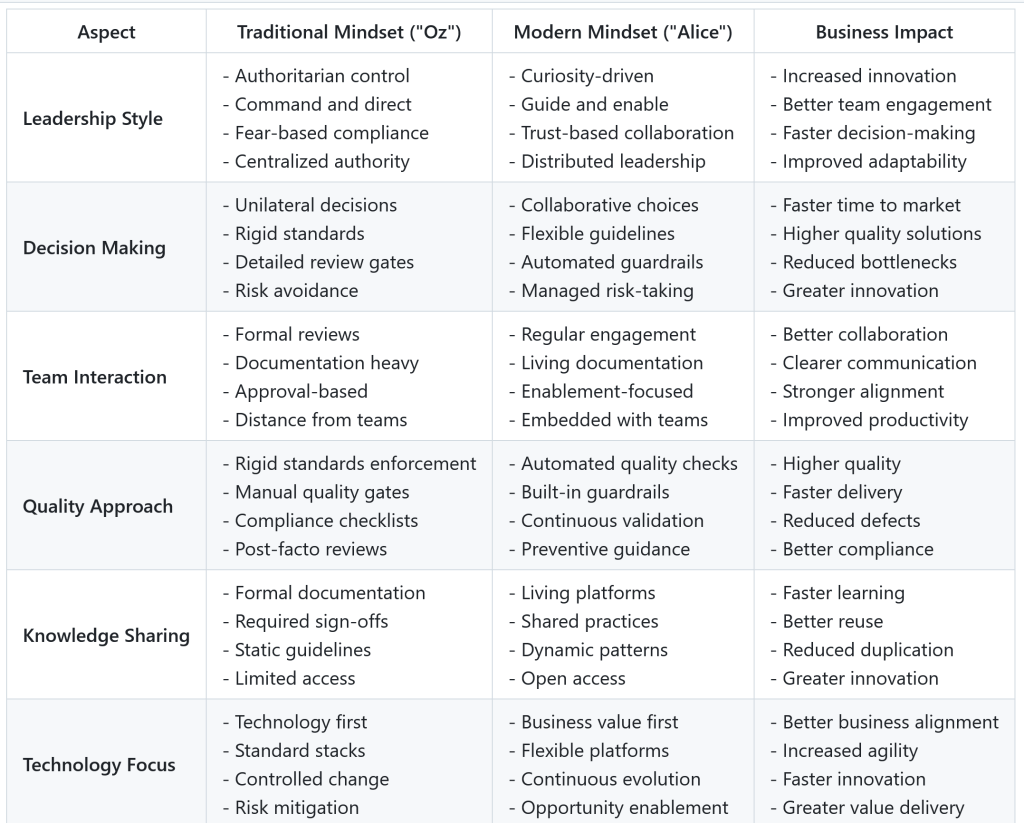
Shawn McCarthy
Key mindset shifts in practice
1. From control to enablement

Shawn McCarthy
2. From documentation to automation

Shawn McCarthy
3. From projects to products
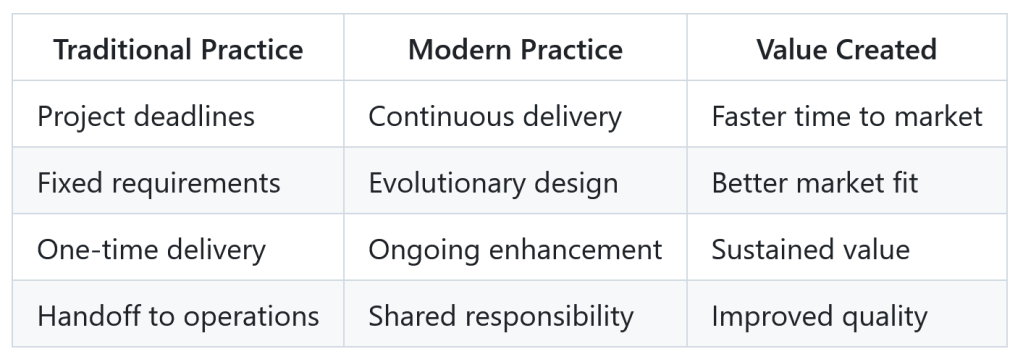
Shawn McCarthy
Key questions for modern architects
- Are teams measuring how well their systems meet defined business outcomes?
- Do engineers understand cohesion and coupling principles in practice?
- Are technical decisions based on change capability rather than novelty?
- How effectively do teams respond to business changes?
- Is the architecture enabling or hindering rapid evolution?
VI. The modern architect: Beyond the blueprint
From dictating designs to facilitating growth
The traditional “master builder” approach positioned architects as the sole authority — handing down designs and ensuring compliance. Modern enterprise architecture, however, demands the mindset of an urban planner: someone who lays out guiding principles, fosters a shared vision and enables diverse teams to shape their environment in a coherent, forward-looking way.
Building consensus vs. enforcing standards
Early architectural models often relied on rigid standards and top-down governance — akin to city ordinances that leave no room for neighborhood character. The modern architect instead focuses on building consensus:
- Collaboration over command: Engaging cross-functional teams, listening to feedback, and making shared decisions
- Guiding principles: Setting clear guardrails rather than voluminous rulebooks — allowing autonomy within well-defined boundaries
- Contextual standards: Encouraging best practices that adapt to different project needs rather than a one-size-fits-all checklist
Embracing the IASA skills and competency model
The International Association of Software Architects (IASA) defines five key pillars of architectural competency that modern architects must master:
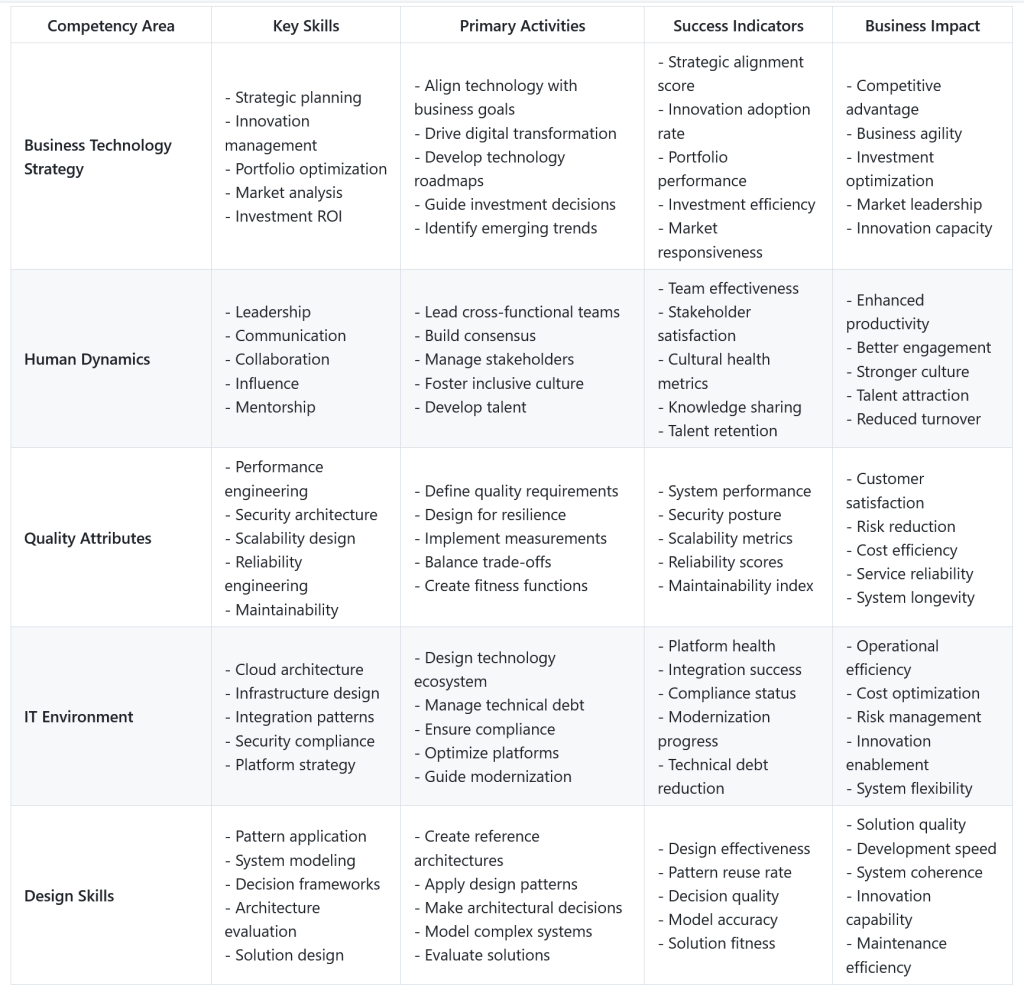
Shawn McCarthy
Each competency area requires both depth and breadth, developing what IASA calls “T-shaped” skills — deep expertise in some areas combined with broad knowledge across many domains. This comprehensive model helps architects become true enablers of organizational success.
Rethinking architecture as an ecosystem
Instead of static blueprints that dictate every detail, modern architects steward an evolving ecosystem — one where teams can continuously refine services, products, and platforms. This approach enables:
- Faster time-to-value: Shortened cycles between idea and production
- De-risked change: Architecture decisions and technology stacks that can shift without major upheavals
- Empowered teams: Autonomy in design choices, backed by shared tools, data and standards that facilitate alignment
- Continuous evolution: Architecture that adapts to changing business needs and technological opportunities
Key focus areas for modern architects
- Vision and strategy
- Develop and communicate clear architectural vision
- Align technical strategy with business objectives
- Create roadmaps for evolutionary change
- Balance innovation with stability
- Platform thinking
- Build reusable capabilities and services
- Create self-service platforms that enable team autonomy
- Establish clear platform governance models
- Monitor and optimize platform adoption
- Community building
- Foster a culture of knowledge sharing
- Build communities of practice
- Enable cross-team collaboration
- Promote architectural thinking at all levels
- Measurement and improvement
- Define clear success metrics
- Implement feedback loops
- Track architectural health indicators
- Drive continuous improvement
Putting it all together
In this urban planner model, the architect’s job is to:
- Envision a cohesive future state aligned to business outcomes
- Enable teams with platforms and best-practice patterns
- Inspire innovation by reducing friction and celebrating collaboration
- Hold the organization accountable for ensuring architectural decisions lead to real, measurable value
The modern architect must balance multiple perspectives and priorities:
- Technical excellence vs. business pragmatism
- Innovation vs. stability
- Standardization vs. flexibility
- Global optimization vs. local autonomy
By moving beyond rigid blueprints and embracing an urban planner ethos, the modern architect helps the enterprise navigate complexity, seize opportunities and build a thriving technology ecosystem — one that combines agility, innovation and clear alignment with strategic goals.
VII. Practical implementation guide
Start by establishing some guiding principles as a reference point but also helping teams through their transformation. Teams should know good enough is acceptable and continuous improvement is encouraged. Make the best recommendations/decisions based on the information at hand.
Phase 1: Foundation building
Just as cities begin with basic infrastructure, we start with:
- Architecture maturity assessment
- Just enough current state knowledge
- Business capability mapping
- Quick win identification
- Baseline metrics establishment
- Initial product domain definition
Phase 2: Transformation launch
Like developing new city districts, we focus on:
- Cross-functional team building
- Measurement framework implementation
- Cultural transformation initiation
- Pilot program launches
- Feedback mechanism establishment
Phase 3: Scale and optimize
Similar to expanding successful urban development patterns:
- Pattern replication
- Framework refinement
- Automation enhancement
- Business integration deepening
- Governance evolution
- Redefining product domains as you learn/mature
VIII. Conclusion: Building tomorrow’s enterprise
The transformation from project-centric to product-oriented architecture represents more than a change in delivery methodology — it’s a fundamental shift in how we create and sustain business value through technology. Just as thriving cities evolve from collections of buildings into vibrant, interconnected communities, our technology landscapes must transform from isolated projects into dynamic product platforms that enable continuous innovation.
Vision of the transformed enterprise
- Platforms that accelerate rather than constrain innovation
- Self-service capabilities that democratize development
- Automated guardrails ensuring continuous alignment with quality attributes
- Transparent portfolio health metrics guiding decisions
- Engaged teams thriving in a culture of continuous learning
- Architecture designed for evolution, not perfection
- Strong technical foundations that enable rapid innovation
In the process, architects step out from behind the mysterious curtain — like Oz — and into a role more akin to the curious and imaginative Alice. By fostering collaboration, curiosity and continuous improvement, you’ll build not just technology solutions, but a resilient digital ecosystem that can adapt to tomorrow’s challenges.
Key takeaways for technology leaders
- Start with business outcomes, not just technical standards
- Align DORA metrics and ISO 25010 quality attributes for holistic insight
- Provide platforms and guardrails that make doing the right thing easy
- Measure what matters — tie metrics to strategic objectives
- Invest in talent and culture: a thriving city needs skilled, motivated citizens
- Design for evolution: domain-driven design and modularity enable faster adaptation
- Continuously share insights and scale successful patterns
Remember, just as great cities aren’t built in a day, this transformation is a journey rather than a destination. The key is to start now, move purposefully, and keep the focus on enabling business outcomes rather than enforcing technical standards. In doing so, you’ll build not just a technology landscape, but a thriving ecosystem that powers your organization’s future success.
Call to action: Starting your transformation
- Assess your current state against the framework provided
- Identify your most pressing improvement opportunities
- Build a coalition of business and technology leaders
- Choose a high-impact pilot area for initial focus
- Establish clear metrics for measuring progress
- Share successes and learnings broadly
- Scale proven patterns across the organization
- Maintain focus on continuous improvement
Organizations that successfully navigate this transformation will build competitive advantages through faster response to market opportunities, more efficient use of technology investments, improved ability to attract and retain talent, enhanced capacity for innovation, and greater business-technology alignment.
The time to start is now. Your technology ecosystem’s future success depends on the foundations you build today.
Shawn McCarthy is vice president and chief architect, Global Architecture, Risk & Governance, at Manulife.
Len van Greuning is chief information officer, Manulife Investment Management.
This article was made possible by our partnership with the IASA Chief Architect Forum. The CAF’s purpose is to test, challenge and support the art and science of Business Technology Architecture and its evolution over time as well as grow the influence and leadership of chief architects both inside and outside the profession. The CAF is a leadership community of the IASA, the leading non-profit professional association for business technology architects.
Read More from This Article: From project to product: Architecting the future of enterprise technology
Source: News

